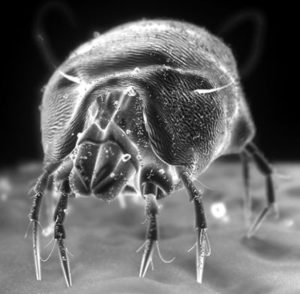March 17, 2017 | Black & Kletz Allergy

Dust mites are microscopic bugs that are about 0.25 mm. in length. They are arachnids like spiders and scorpions and like the former, generally have 8 legs. They tend to live in pillows, mattresses, bedding, carpeting, plush toys, upholstered furniture, etc. and are responsible for allergy and asthmasymptoms in many individuals. When someone speaks of a dust allergy, they are in fact referring to dust mite allergy. Dust mites can survive in a broad range of environmental conditions but prefer warmer temperatures and places with higher humidity. They tend not to like high altitudes, but still can survive at relatively high elevations. Dust mites survive by eating organic matter such as your flaky dead skin that sloughs off of you each night while you are asleep. They also eat your hair, fingernails, fungi, bacteria, and can eat animal fur. For these reasons, dust mites tend to be most problematic in one’s bedroom. In addition, people tend to spend a lot of time in their bedrooms. A disgusting fact is that there are millions of these tiny bugs living on the average mattress.
Why are people allergic to them and what are the symptoms of dust mite allergy?
People are actually allergic to the allergens in the dust mite’s fecal material. The two most common species of dust mites found in the United States are Dermatophagoides farinae and Dermatophagoides pteronyssinus. There are many dust mite allergens which are divided into groups. The allergens in Group 1 and Group 2 are generally the most bothersome to individuals. The allergens “Der f 1” and “Der p 1” are the most allergenic proteins that are produced by these two mites. When a sensitized individual inhales these proteins, as well as other dust mite proteins, allergic symptoms may occur which can cause all or some of the following symptoms: itchy eyes, watery eyes, red eyes, runny nose, nasal congestion, post-nasal drip, sneezing, sinus headaches, wheezing, cough, shortness of breath, and/or chest tightness. These symptoms can be the same symptoms as some people experience with pollen, mold, and/or pet allergies. In addition, dust mites may cause exacerbation of one’s eczema (atopic dermatitis).
What can be done to minimize one’s exposure to dust mites?
It is advantageous to cover one’s pillows, mattress, and box spring with allergy-proof encasings that zipper up over the pillows, mattress, and box spring. This allows one to have a “protective” barrier in place between the dust mites and the individual’s nose which is responsible for inhaling the highly allergenic proteins of the dust mites. It is also beneficial to avoid wall-to-wall carpeting, especially in the bedroom and to get rid of plush stuffed animals in children’s bedrooms. Anything that tends to gather dust such as curtains also should be avoided. In addition, it is also beneficial to wash bedding in water that is equal to or greater than 130°F. The hot water will kill the dust mites, although dust mites will continue to reproduce and always will be present. Using a HEPA air filter is another important tool to reduce allergen exposure. Make sure to keep the humidity in the house below 50% as it has already been mentioned above that dust mites thrive in high humidity, particularly over 70% humidity. It is preferable to avoid sleeping in basements, as they tend to be damper and concrete floors also should be avoided, since they tend to increase moisture.
How is dust mite allergy diagnosed and treated?
When an individual sees a board certified allergist, it is important for the allergist to take a detailed history from the patient so as to ascertain if his/her symptoms could possibly be due to dust mites. One common feature amongst people with dust mite allergies is that their symptoms can and usually are perennial in nature and not just seasonal as found often in patients with pollen allergies. It is also very common for patients with dust mite allergy to have a worsening of their symptoms in the Fall and Winter, which is usually the time that the heat gets turned on in most homes and businesses, particularly in the Washington DC, Northern Virginia, and Maryland metropolitan area. The next step in diagnosing dust mite allergy is a thorough physical examination to look for visual clues of hay fever (allergic rhinitis) and/or asthma. Allergy skin testing or allergy blood testing can be performed in order to confirm the diagnosis. Once a dust mite allergy is diagnosed, there are a few options for treatment which involve a combination of reducing one’s exposure to dust mites as mentioned in the previous paragraph, and medical treatment. Treatment can be given to patients by either using medications and/or receiving allergy immunotherapy (i.e., allergy shots, allergy desensitization). Allergy medications may include antihistamines, decongestants, nasal sprays, and/or eye drops, etc. Allergy desensitization has been around for over a century and has been proven to be very effective to treat dust mite allergies, as well as pollen, mold, pet, insect sting hypersensitivity, etc.
What should you do next?
The allergists at Black & Kletz Allergy are board certified in both adult and pediatric allergy, asthma, and immunology. We are proud to have served the Washington DC metropolitan area community for many decades and if you or someone you know appears to be suffering from “dust” allergies or allergies due to an “unknown” cause, please give us a call at one of our 3 convenient office locations in the area or click Request an Appointmentand we will contact you within 24 hours on the next business day after your request, so that we can schedule an appointment for you.












